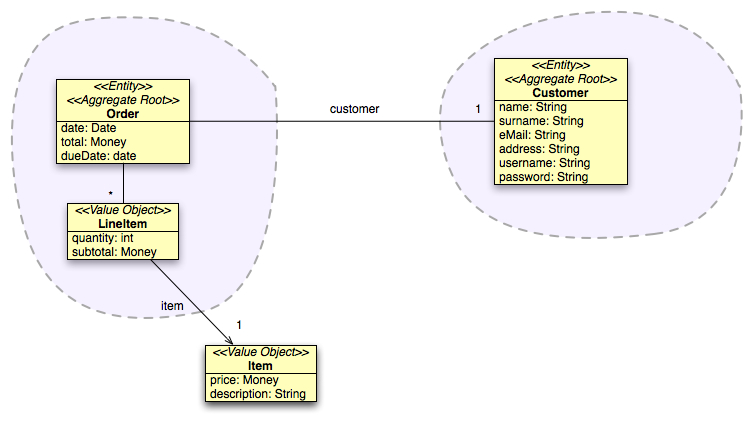And if you're masochistic enough to stand my accent ...here is the video.
Sunday, October 17, 2010
Loosely Coupled Complexity - Unleash the power of your Domain Model with Command Query Responsibility Segregation and Event Sourcing
And if you're masochistic enough to stand my accent ...here is the video.
Tuesday, October 12, 2010
DDD Reference Links
Further references
Books
Domain Driven Design - Eric Evans (Addison Wesley)
The official starting point for Domain Driven Design, covering the topic form tactical to strategical.
Applying Domain-Driven Design and Patterns (Addison Wesley)
A more implementation related approach focusing on the mechanics of the implementation of tactical DDD with C# and .Net.
DDD Quickly
A free dowloadable smaller reference for Tactical DDD from InfoQ
http://www.infoq.com/minibooks/domain-driven-design-quickly
Domain Driven Design website
New official website for Domain Driven Design. Aggregator for further resources, informations, discussion and events
http://domaindrivendesign.org/
Domain Driven Design User Group
This is the place where the most interesting discussions are hosted
http://tech.groups.yahoo.com/group/domaindrivendesign/
Italian Domain Driven Design group
http://it.groups.yahoo.com/group/DDD-IT/
Eric Evans interviews and talks on InfoQ
http://www.infoq.com/interviews/domain-driven-design-eric-evans
http://www.infoq.com/presentations/model-to-work-evans
http://www.infoq.com/articles/eric-evans-ddd-matters-today
http://www.infoq.com/presentations/strategic-design-evans
http://www.infoq.com/presentations/ddd-dsl-evans
DDD sample Application
A working implementation of DDD principles in SpringMVC plus Hibernate, maintained by Swedish company Citerus.
http://dddsample.sourceforge.net/
CQRS & Event Sourcing
I needed a separate page for that:
http://ziobrando.blogspot.com/2010/10/cqrs-event-sourcing-reference-links.html
DDD, TDD & BDD
The three amigos: DDD, TDD & BDD Presentation by Gojko Adzic
http://skillsmatter.com/podcast/design-architecture/ddd-tdd-bdd
Gojko Adzic’s Blog: http://gojko.net/
Context mapping
Strategic Domain Driven Design with Context mapping (My article on InfoQ)
http://www.infoq.com/articles/ddd-contextmapping
Context Mapping in Action - Presentation by Alberto Brandolini
http://skillsmatter.com/podcast/design-architecture/context-mapping-in-action
Articles
About entities, aggregates and data duplication - Alberto Brandolini’s blog
http://ziobrando.blogspot.com/2010/06/about-entities-aggregates-and-data.html
Random Links
Kent Beck blog entry on why writing maintainable software matters.
http://www.threeriversinstitute.org/blog/?p=104
Some more related or interesting books
Patterns of Enterprise Application Architecture - Martin Fowler
Analysis Patterns - Martin Fowler
Growing Object Oriented Software, guided by tests - Steve Freeman & Nat Pryce
The Pragmatic Programmer - Dave Thomas and Andy Hunt
Clean Code - Robert C. Martin
Agile Software Development, Pattern Principles and Patterns
Lean Software Development - Mary and Tom Poppendieck
Test Driven Development by Example - Kent Beck
Collaboration Explained - Jean Tabaka
CQRS & Event Sourcing Reference Links
CQRS & Event Sourcing
DDD/CQRS Mailing list
Interviews
Eric’s interview to Greg Younghttp://www.infoq.com/interviews/Architecture-Eric-Evans-Interviews-Greg-YoungClarified CQRS - Article by Udi Dahan
Presentations
Command Query Responsibility Segregation - Presentation by Udi Dahanhttp://www.infoq.com/presentations/Command-Query-Responsibility-SegregationAvoid a failed SOA - Presentation by Udi Dahan
http://www.infoq.com/presentations/SOA-Business-Autonomous-Components
Event Sourcing
Event Sourcing definition by Martin Fowler
http://martinfowler.com/eaaDev/EventSourcing.htmlInnovation and Event Sourcing - Greg Young presentation
http://skillsmatter.com/podcast/design-architecture/architectural-innovation-eventing-event-sourcingCode References
Super Simple CQRS Example
http://codebetter.com/blogs/gregyoung/archive/2010/08/31/super-simple-cqrs-example.aspxWednesday, June 16, 2010
Agile Testing UK meetup
While in England for DDD Exchange, I caught the opportunity to participate in a meetup of the UK Agile Testing community. Gojko Adzic led a very interesting workshop about how to write acceptance tests.
Neil McLaughlin, who happened to be in my team in the hands-on simulation wrote a nice report on the evening, and then Gojko himself posted about what he showed us. I'll try add something, from the participant perspective.
The developer mindset
Given we had quite a few people in the room, around 60, it was really interesting to note all different behaviors, but there were also some striking similarities. Most of the discussion we had were focused on
- Formal correctness of the test
- Splitting tests to be testing one concern at that time
- avoiding duplication in test fixture setup
When discussing the outcome, Gojko pointed out that the main concern for acceptance tests was readability, instead. Readability is a subjective evaluation criteria, and might lead to a not-so-precise definition about how to make it right. But that's the only way to write a useful acceptance test. But the developer's mindset really had a strong influence on us, it was really hard to give up.
Constrained by the tools
Despite Skills Matter (that was hosting the evening) doing a fantastic job in providing an impressive amount of whiteboards for all the team, some of the discussions were constrained by the amount of space available on the whiteboard, so we ended up pruning some concerns, thinking they were of little value to the discussion. It turned out we were wrong.
But, as I said, we had an amount of writable space that was a lot larger than what I normally found in a typical workplace... and still this was constraining us. Buying one more whiteboard is cheap, making wrong assumptions because of writable space constraints is a lot more costly.
We're problem solvers, after all
During the exercise, Gojko was wandering around from one team to another one, playing the role of the Domain Expert. However, most of the teams seemed more interested in his Teacher role and asked some questions about how to solve the exercise, but barely none about ambiguities in the domain. We preferred to use assumptions instead.
Even if I knew the trick, it worked on me as well. But it's scary to note that even when writing acceptance tests, which are a lot more translation than design, our built-in problem solving brain leads us so easily on the road of guessing instead of asking.
Tuesday, June 15, 2010
About Entities, Aggregates and Data Duplication.
There's been an interesting discussion about Aggregates on the Italian DDD mailing lists. When things become complex, a simple example might just turn too simple. So I came up with this medium-sized one. Hope it won't be too long. Ok, so let's start from our first User Story
User Story #1: Placing an order
As a Customer
I Want to place an order
In order to purchase some goods
The simplest implementation of the story is essentially stateless: every time a customer wants to order something, needs to re-enter the data. In the DDD perspective, the resulting model is based on a single aggregate (we're deliberately ignoring the catalog for now) whose root is the Order class.
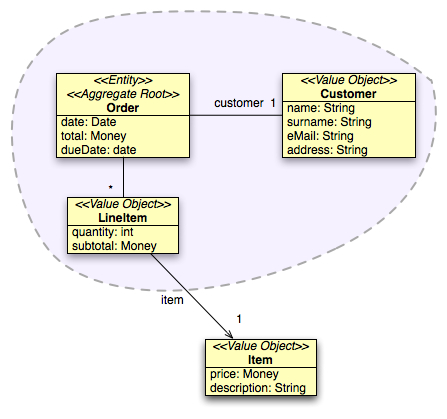
The stateless nature of the service makes it really easy to implement: a Customer is just a Value Object, created and eventually dropped at needs. Also we took some shortcut: we've chosen to implement Address as a String. Item is sort of natural value object, while LineItem is somewhat in the middle: we can change quantities, while the order is in open state, but we can implement this also using droppable Value Objects, easing the integrity burden for the aggregate root.
Some businesses (like buying train tickets) might just work like this, but our marketing is more inclined to manage customers in a more long-term way, so here are two more user stories.
User Story #2: Returning customer
As a Customer
I Want to retrieve my profile
In order to place more orders
Story #2 breaks our assumption about the aggregate boundaries. If we stick to the aggregate rule-of-thumb, if we want to delete an Order, we probably don't want to delete also the corresponding Customer. So we need a separate aggregate for that. What would happen if we decide to delete a Customer? Should we delete all orders? We don't have enough information to answer that, yet, we'll mark it as an outstanding question for our next meeting with the domain expert. Let's try the model with two aggregates and see how does it perform.
We now have a relationship crossing the aggregate boundary. We have promoted Customer to become the root of the newly created aggregate, so there is no potential integrity violation. Still we have to watch it closely, because this is where problems related to lazy/eager loading will arise. We also added username and password to Customer.
User Story #3: Different shipping address
As a Customer
I Want to specify a valid shipping address
In order to ship to a different destination
Multiple addresses are a call for a separate type to manage Address. We don't have so many responsibilities so far, for this class, except validation (which as Udi Dahan would say, doesn't necessarily belong to the domain layer) but the smell of duplication is probably enough to go for a separate class. We try to keep the model as simple as possible, so we treat Address like a value object.
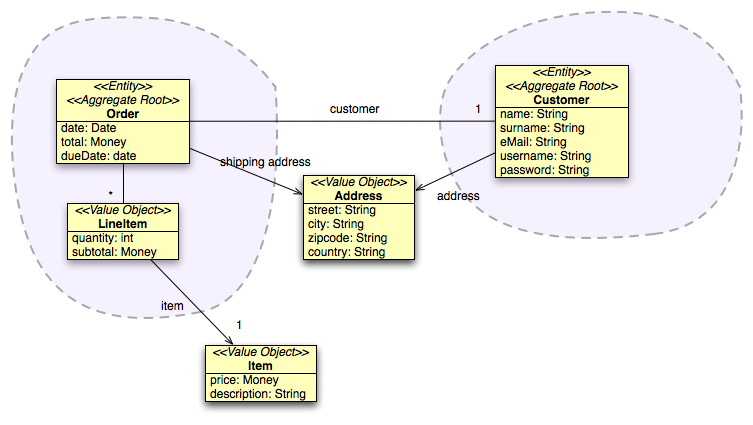
User Story #4: Editable customer profile
As a Customer
I Want to edit my profile
In order to update it if needed
Story #4 makes explicit what we've been suspecting: Customer needs to be an entity, because it has a nontrivial lifecycle. No revolutions at Domain Model level, but this triggers a question: "What happens if I have an outstanding order and the customer changes its data before the order is dispatched?" This is the type of questions you don't want to answer as software developer. So we walk up the stairs to have a talk with the Domain Expert. We come back with two fresh user stories:
User Story #5: Specify Billing and Shipping address
As a Customer
I Want to specify independent billing and shipping addresses
In order to deliver goods to different locations
This one is relatively easy: just reinforcing our design. We'll now have two references from Order to Address, which are managed by the Customer. We just store a default Address in the Customer aggregate (we could do better) but's ok for now.
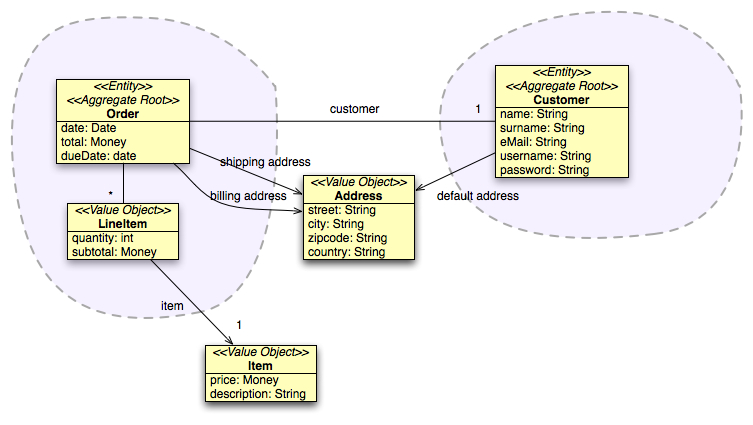
Story #6 is a little trickier, it comes from the legal department and tell us what we probably expected.
User Story #6: Track past orders
As a Legal Department
I Want to track orders
In order to in order to manage litigations
The domain expert state it clear: once an order is placed, it can't be changed in any of its parts, be it the content or the Customer. In case of litigation, it must behave exactly like printed paper. But Customer does not, its lifecycle is different from our needs, we'd need a separate class for that. We're lacking fantasy and call it CustomerData.
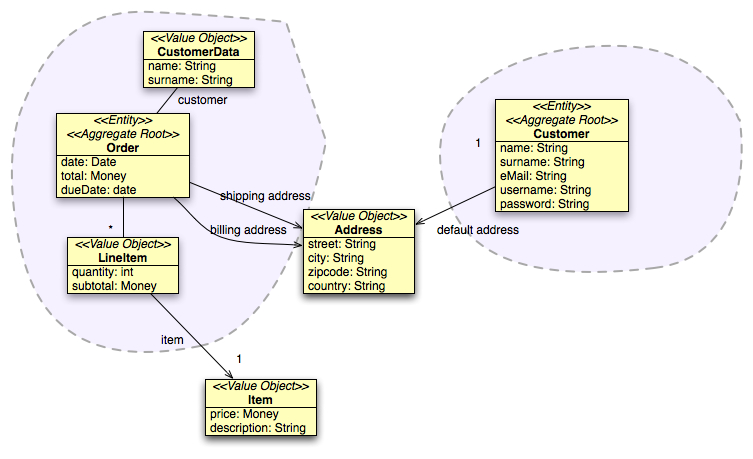
Everything is looking a lot different from the beginning. The two aggregates are now largely decoupled: we can change or delete an order without affecting the customer or deleting or unregistering a customer without losing tracks of its past orders. On the other hand we have explicit duplication here. Customer and CustomerData look so similar we're feeling guilty. Did we violate DRY principle? At first look the data is the same, but if we think about behavior, or class lifecycle, Customer and CustomerData are clearly two different beasts. But more often than not, when the starting point is the data model, instead of the domain model we end up thinking that's the same data, hence the same class. I bet experienced data modelers do not fall into these pitfalls as well, but I've seen these problems recurring quite often.
Once we accept that little bit of data duplication we have a system which is a lot easier to evolve and maintain, with aggregate roots as integrity enforcers within their boundaries, and agnostic about the rest.
To add some salt, don't forget aggregates are also building blocks of distributed systems: suppose we'll need to send orders to a remote system. Sending just the single aggregate and the referenced value objects is probably the cleanest way.
Friday, May 07, 2010
Software ...e tutto ciò che comporta
Tuesday, February 02, 2010
Some thoughts on the iPad
Only time and revenues will tell who's right: but I think a few things that emerged from recent discussions are worth thinking about.
It's all about being sexy
What's the ugliest part of an electronic device? Cables. They're messy, and despite every effort to make them look pleasant ...they are ugly, and probably always will. I suspect that the lack of connectors is a way to discourage users from plugging in many devices: famous actresses look a lot more ordinary without the make up. And they hate showing up in public if they have some imperfections on the skin. It's called vanity. The best way to satisfy vanity is to make the iPad an essentially wireless device. Cables are for losers, they're necessary, but only when nobody's watching.
However, if you still feel like you need to upload pictures, connect to external devices... you'll maybe end up buying another device like the AirPort.
Gestures matters
Some folks complained it's less than an iPhone. Wow ...it's big! Do you really would like to phone with a big device like this? It doesn't feel natural. Our body learned to associate gestures with situations, and we phone with small objects (like ...phones) and we read with bigger ones (like magazines, books and newspapers). I think the whole idea is to make the device feel natural. Things or actions that wouldn't fit the device were simply not included.
Looks like the whole idea is to be a device do be used on the couch. Relaxed, and quiet. Like ...reading a book, but not necessarily so.
A pleasant experience
iBook and the relative store, are more than a hint that Apple is engaging Amazon in the book battle. Some friends noted that reading a book requires a different display, to be a pleasant experience for the eye. I think they're right on this. Sill the iPad is not a device to do one thing (as it is for Kindle) but to do many. And not all of them are necessarily known from the beginning.
No multitasking
Some people consider the lack of multitasking capabilities as a key missing feature on the iPad. I think the opposite. Frequent interruptions are stressing, and to me the iPad looks like a thing to do one thing at a time (which by the way is the basic mantra of GTD, Kanban and so on). If you want to torture yourself by being continuously interrupted, a phone or a PC are the tools for you, and this is what you probably use for working. But if you want to please yourself, relaxing on the couch, the only other thing to do while using the iPad is probably having a glass of good wine. Or maybe that's the picture of you that will stick in your brain to make you buy that thing.
I suspect that also the lack of a camera has something to do with that. I mean ...Apple put cameras in MacBooks ages ago: they know how to build devices with cameras. But the stressing feeling of being continuously reachable is what makes people hate cell phones. A device that allows you to surf/read without being interrupted that often, could be loved by some.
It's not for the geeks
Maybe I am a little bit too far on this, but I think the iPad is targeted to a part of the market that had been partially untouched from other Apple products. Think about the agenda: it really feels like a real agenda, with all the potential of an application. There are quite a few users that still prefer planning on paper rather than on a blackberry or an iPhone, cause you don't see the whole picture there. More generally, geeks feel comfortable with complexity and multitasking. Many folks don't.
I have to admit i bought the iPhone for 2 reasons: learning and vanity. The reasons I use it now are completely different, and I discovered them while using it. So I think it's still early to have a precise idea of the potential, and of the marketing success, but really looks like "less is more" has been a design driver this time.
Tuesday, January 12, 2010
We can do better than this... Reloaded
One thing that really disappoints me is the low quality of many software applications I have to deal with in my everyday life. Some days I really feel like I am surrounded by crap. Just to make it clear what I am talking about: here is an excerpt of what a home banking service is asking me every single operation I do.
And every time I think: "It's one account, it's just one account, it's always been just one account, so why on Earth you keep asking me this question every time! Couldn't you just take me straight to the account...".
Some days I just feel like surrender, some other I see how some application are doing a fantastic job, on platforms like iPhone or on the web, and I feel like there's still some hope for us.
There is still a lot to do
Despite all of our efforts, to introduce TDD and continuous integration, velocity based estimations and the like. There's a lot to do in other fields as well. Let me say it in another way: many companies are looking towards agile methodologies as a way to improve their development processes, in order to deliver software on time and on budget.
Doesn't sound that bad isn't it?
It does. It doesn't mention the quality of the product. ...Oh, yes, we forgot, we need also tests to reduce our defect ratio. Tests are good, software quality is good, but still doesn't address the whole point. We should deliver better products. Emphasis on the process itself would satisfy the managers' ancient need for schedules and predictable outcome, allowing teams to produce crap more efficiently, but would not produce better products unless some key points are specifically addressed.
The most neglected areas at the moment - at least from my point of observation - are:
- user's involvment,
- understanding the domain complexity,
- lack of an overall perspective,
- inefficient learning during the product development lifecycle.
In the next posts I'll dig deeper in these topics.
Monday, January 04, 2010
New DDD training events in Bologna
- 1 introduction day, targeted to who want's to know what DDD is, on February 8th (info & registration)
- 4 days of workshop from February 9th to 12th for practitioners that want to dig deeper and discuss (info & registration)
The events will take place in Savoia Regency Hotel (well known to participants of last Italian Agile Day). Early bird till January 15th, and special discounts for Bologna XPUG menbers.
